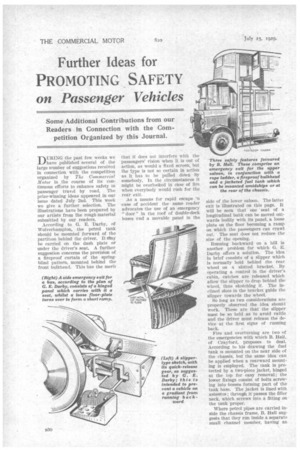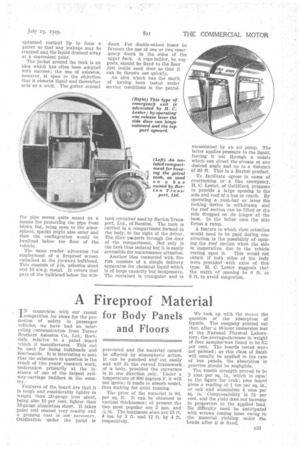Further Ideas for PROMOTING SAFETY on Passenger Vehicles
Page 56

Page 57

If you've noticed an error in this article please click here to report it so we can fix it.
Some Additional Contributions from our Readers in Connection with the Competition Organized by this Journal.
DURING the past few weeks we have published several of the large number of suggestions received in connection with the competition organized by The Commercial Motor in the course of its continuous efforts to enhance safety in passenger travel by road. The prize-winning ideas appeared in our issue dated July 2nd. This week we give a further selection. The illustrations have been prepared by our artists from the rough material submitted by our readers.
According to G. E. Darby, of Wolverhampton, the petrol tank should be mounted forward of the partition behind the driver. It ntay be carried on the dash plate or under the driver's seat. A further suggestion concerns the provision of a fireproof curtain of the springblind pattern, mounted behind the front bulkhead. This has the merit
that it does not interfere with the passengers' vision when it is out of action, as would a fixed screen, but the -type is not so certain in action as it has to be pulled .down • by somebody. In the circumstances it might be overlooked in case of fire when everybody would rush for the rear exit.
As a means for rapid escape 411 case of accident the same reader advocates the use of an emergency " door " in the roof of double-deck buses end a movable panel in the
side of the lower saloon. The lattei exit is illustrated on this page. It will be seen that one 'seat of a longitudinal bank can be moved outwards bodily with its panel, a loose plate on the floor becoming a ramp on which the passengers can crawl out. The seat does not reduce the size of the opening.
Running backward on a hill is another problem for which G. E. Darby offers a solution. The idea in brief consists of a slipper which is normally held behind the rear wheel on a slotted bracket. By operating a control in the driver's cabin, catches are released which allow the slipper to drop behind the wheel, thus skotching it. The inclined slots. in the bracket guide the slipper towards the wheel.
So long as two considerations are properly observed the idea should work. These are that the slipper nutst be so held as to avoid rattle and the driver must release the device at the first signs of running back.
Fire and overturning are two of the emergencies with which B. Hall, of Crayford, proposes to deal. According to his drawing the fuel tank is mounted on the near side t,f the chassis, but the same idea can be applied when a rearward mounting is employed. The tank is protected by a two-piece jacket, hinged at the top for easy removal; the lower fixings consist of bolts screwing into bosses forming part of the tank base. The jacket is lined with asbestos; through it passes the filler neck, which screws into a fitting on the tank proper.
Where petrol pipes are carried inside the chassis frame, B. Hall suggests that they run inside a separate small channel member, having an upturned vertical lip to form a gutter so that any leakage may be trapped and the liquid drained away at a convenient point.
The jacket around the tank is an idea which has often been adopted with success; the use of asbestos, however, is open to the objection that it absorbs liquid and thereafter acts as a wick. The gutter around the pipe seems quite sound as a means for protecting the pipe from blows, but, being open to the atmosphere, sparks might also enter and then the conflagration would be localized below the floor of the vehicle.
The same reader advocates the employment of a fireproof screen embodied in the forward bulkhead. This consists of 1-in. asbestos sheet and 16 sTw.g. metal. It covers that part of the bulkhead below the win
dows. , For double-saloon buses be favours the use of one or two emergency doors in the sides of the upper deck. A rope ladder, he suggests, should be fixed to the floor just inside each door so that it can be thrown out quickly.
An idea which has the merit of having been tested under service conditions is the petrol tank container used by Barton Transport, Ltd., of Beeston. The tank is carried in a compartment formed in the body, to the right of the driver. The filler projects through the door of the compartment. Not only is the tank thus isolated but it is easily accessible for maintenance attention.
Another idea connected with fire risk consists of a simple delivery apparatus for chemical liquid which is of large capacity but inexpensive. The container is triangular and is surmounted by an air pump. The latter applies pressure to the liquid, forcing it out through a nozzle which can direct the stream at any desired angle and up to a distance of 30 ft. This is a Barton product.
To facilitate egress in cases of overturning or a like emergency, H. C. Lester, of Guildford, proposes to provide a large opening in the side and roof of a bus or coach. By operating a push-bar or lever the locking device is withdrawn and the roof section can be lifted or the side dropped on its hinges at the base. In the latter case the side forms a ramp.
A feature to which close attention would need to be paid during construction is the possibility of opening the roof section when the side is inoperative, due to the vehicle
resting upon it. This would not obtain if both sides of the body were provided with exits of this type. H. C. Lester suggests that the width -of opening be 6 ft. to 8 ft to avoid congestion.




















































































































